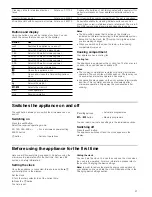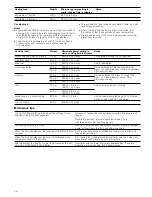
27
Changing the programme
Once you have started the programme, the programme number
and weight cannot be changed.
Changing the cooking time
With automatic programmes, you cannot change the cooking
time.
Notes on the automatic programmes
Notes
■
Take the food out of its packaging and weigh it. If it is not
possible to enter the exact weight, you should round it up or
down.
■
For the programmes, always use microwave-proof cookware,
e.g. made of glass or ceramic. Observe the accessories tips
in the programme table.
■
Place the food in the cold appliance.
■
It is not possible to set a weight outside the weight range.
■
With many dishes, a signal sounds after a certain time. Turn
or stir the food.
■
A table of suitable types of food with appropriate weight
ranges and the accessories required can be found in the
section after the notes.
Defrosting
Notes
■
As far as possible, freeze and store food flat and in portion-
sized quantities at -18 °C.
■
Place the frozen food on a flat dish, e.g. a glass or porcelain
plate.
■
After defrosting in the appliance, leave the food to continue
defrosting for a further 10 to 30 minutes until it reaches an
even temperature.
■
Liquid will be produced when meat, poultry or fish is
defrosted. Drain off this liquid when turning meat and poultry
and under no circumstances use it for other purposes or
allow it to come into contact with other foods.
■
Place beef, lamb and pork on the cookware fatty-side down
first.
■
Bread should only be defrosted in the required amounts, as it
quickly becomes stale.
■
After turning, remove any minced meat that has already
defrosted.
■
Whole poultry should be placed in the cookware breast-side
down and poultry portions skin-side down.
Potatoes
Notes
■
Boiled potatoes: cut into equal sized pieces. Add a little salt
and 2 tablespoons of water for every 100 g of potatoes.
■
Potatoes boiled in their skins: use potatoes of equal size.
Wash the potatoes and prick the skin several times. Place the
wet potatoes in a dish. Do not add water.
Rice
Notes
■
Rice foams a lot during cooking. Therefore, use a high-sided
dish with a lid. Enter the uncooked weight (without liquid).
Add two to two and a half times the amount of liquid to the
rice.
■
Do not use boil-in-the-bag rice.
Vegetables
Notes
■
Fresh vegetables: cut into pieces of equal size. Add
2 tablespoons of water for every 100 g vegetables.
■
Frozen vegetables: this programme is only suitable for
blanched, not pre-cooked vegetables. It is not suitable for
frozen vegetables in cream sauce. Add 1 to 2 tablespoons of
water per 100 g. Do not add water to spinach or red
cabbage.
Resting times
Some dishes need to rest in the oven after the programme has
ended.
Programme table
Dish
Resting time
Vegetables
approx. 5 minutes
Potatoes
approx. 5 minutes. First pour off the
remaining water.
Rice
5 to 10 minutes
Progr. no. Suitable food
Weight range in kg
Cookware
Defrost
P1
Meat and poultry
Joints
Flat pieces of meat
Mince
Chicken, poulard, duck
0.2 - 2.0 kg
Shallow cookware without lid
P2
Fish: whole fish, fish fillet, fish cutlet
0.1 - 1.0 kg
Shallow cookware without lid
P3
Bread and cake*
Bread, whole, round or long, bread in slices,
sponge cake, yeast cake, fruit flan
0.2 - 1.5 kg
Shallow cookware without lid
Cooking
P4
Potatoes
Boiled potatoes, potatoes boiled in their skins
0.2
1.0 kg
Dish with lid
P5
Rice
0.05
0.3 kg
High-sided dish with lid
P6
Fresh vegetables
Cauliflower, broccoli, carrots, kohlrabi, leeks, pep-
pers, courgettes
0.15
1.0 kg
Dish with lid
P7
Frozen vegetables
Cauliflower, broccoli, carrots, kohlrabi, red cab-
bage, spinach
0.15
1.0 kg
Dish with lid
Observe the signals for stirring and turning.
* Cream cakes, buttercream cakes, cakes with frosting, icing or gelatine are unsuitable.






































